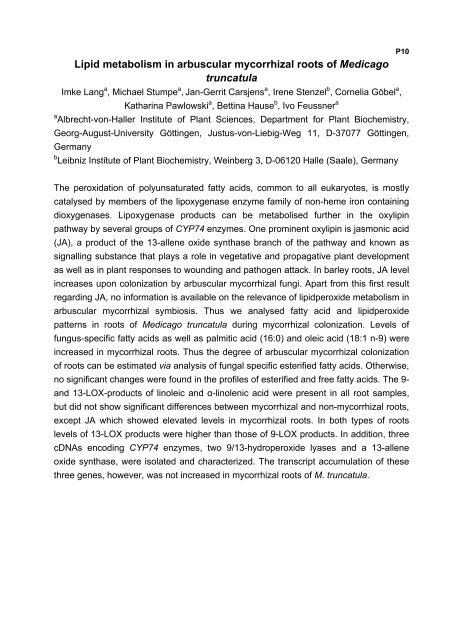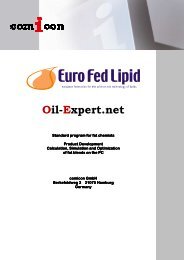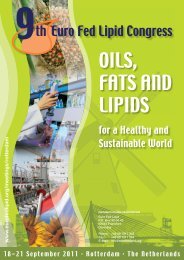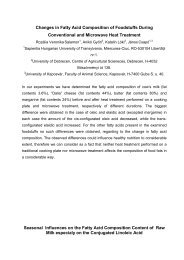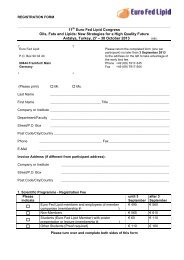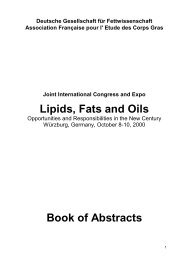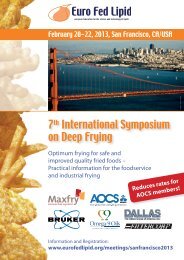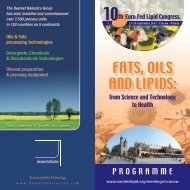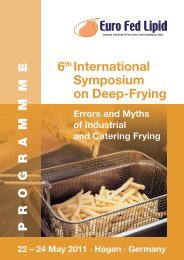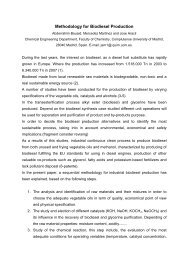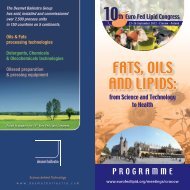Abstracts now available online - Euro Fed Lipid
Abstracts now available online - Euro Fed Lipid
Abstracts now available online - Euro Fed Lipid
Create successful ePaper yourself
Turn your PDF publications into a flip-book with our unique Google optimized e-Paper software.
<strong>Lipid</strong> metabolism in arbuscular mycorrhizal roots of Medicago<br />
truncatula<br />
Imke Lang a , Michael Stumpe a , Jan-Gerrit Carsjens a , Irene Stenzel b , Cornelia Göbel a ,<br />
Katharina Pawlowski a , Bettina Hause b , Ivo Feussner a<br />
a<br />
Albrecht-von-Haller Institute of Plant Sciences, Department for Plant Biochemistry,<br />
Georg-August-University Göttingen, Justus-von-Liebig-Weg 11, D-37077 Göttingen,<br />
Germany<br />
b<br />
Leibniz Institute of Plant Biochemistry, Weinberg 3, D-06120 Halle (Saale), Germany<br />
The peroxidation of polyunsaturated fatty acids, common to all eukaryotes, is mostly<br />
catalysed by members of the lipoxygenase enzyme family of non-heme iron containing<br />
dioxygenases. Lipoxygenase products can be metabolised further in the oxylipin<br />
pathway by several groups of CYP74 enzymes. One prominent oxylipin is jasmonic acid<br />
(JA), a product of the 13-allene oxide synthase branch of the pathway and k<strong>now</strong>n as<br />
signalling substance that plays a role in vegetative and propagative plant development<br />
as well as in plant responses to wounding and pathogen attack. In barley roots, JA level<br />
increases upon colonization by arbuscular mycorrhizal fungi. Apart from this first result<br />
regarding JA, no information is <strong>available</strong> on the relevance of lipidperoxide metabolism in<br />
arbuscular mycorrhizal symbiosis. Thus we analysed fatty acid and lipidperoxide<br />
patterns in roots of Medicago truncatula during mycorrhizal colonization. Levels of<br />
fungus-specific fatty acids as well as palmitic acid (16:0) and oleic acid (18:1 n-9) were<br />
increased in mycorrhizal roots. Thus the degree of arbuscular mycorrhizal colonization<br />
of roots can be estimated via analysis of fungal specific esterified fatty acids. Otherwise,<br />
no significant changes were found in the profiles of esterified and free fatty acids. The 9-<br />
and 13-LOX-products of linoleic and α-linolenic acid were present in all root samples,<br />
but did not show significant differences between mycorrhizal and non-mycorrhizal roots,<br />
except JA which showed elevated levels in mycorrhizal roots. In both types of roots<br />
levels of 13-LOX products were higher than those of 9-LOX products. In addition, three<br />
cDNAs encoding CYP74 enzymes, two 9/13-hydroperoxide lyases and a 13-allene<br />
oxide synthase, were isolated and characterized. The transcript accumulation of these<br />
three genes, however, was not increased in mycorrhizal roots of M. truncatula.<br />
P10


